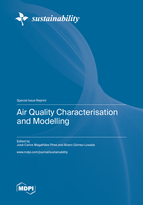Air Quality Characterisation and Modelling
A special issue of Sustainability (ISSN 2071-1050). This special issue belongs to the section "Environmental Sustainability and Applications".
Deadline for manuscript submissions: closed (15 January 2023) | Viewed by 41515
Special Issue Editors
Interests: CO2 capture; wastewater treatment; microalgal biofuels; process modelling
Special Issues, Collections and Topics in MDPI journals
Interests: air pollution; environmental data science; knowledge discovery from databases; spatial and temporal forecasting; statistics data mining methods; machine learning
Special Issue Information
Dear Colleagues,
Air pollution is a mixture of particles and gases, which can reach unsafe concentrations for human health, the environment, vegetation and materials. It has become one of the main sustainability issues and a concerning topic in atmospheric science. According to the World Health Organization (WHO), 90% of the world’s population lives in highly polluted environments, and about 7 million premature deaths are caused every year by outdoor and indoor air pollution. The combination of fast-growing populations, transport, fossil fuels, and biomass burning is leading to pollution levels being especially high in some urban areas. Agriculture and natural phenomena are also an important source of pollution, underscoring the multi-faceted and transboundary nature of air pollution. The monitoring and understanding of the temporal and spatial behaviours of air pollutant concentrations are essential for both the implementation of air quality policies and the definition of effective measures to mitigate air pollution and its effects. Quantifying and monitoring exposure to air pollution in terms of public health is also a critical component in policy discussion.
This Special Issue will present recent research activities concerning the characterization of air pollution and the applied modelling approaches.
Dr. José Carlos Magalhães Pires
Prof. Dr. Álvaro Gómez-Losada
Guest Editors
Manuscript Submission Information
Manuscripts should be submitted online at www.mdpi.com by registering and logging in to this website. Once you are registered, click here to go to the submission form. Manuscripts can be submitted until the deadline. All submissions that pass pre-check are peer-reviewed. Accepted papers will be published continuously in the journal (as soon as accepted) and will be listed together on the special issue website. Research articles, review articles as well as short communications are invited. For planned papers, a title and short abstract (about 100 words) can be sent to the Editorial Office for announcement on this website.
Submitted manuscripts should not have been published previously, nor be under consideration for publication elsewhere (except conference proceedings papers). All manuscripts are thoroughly refereed through a single-blind peer-review process. A guide for authors and other relevant information for submission of manuscripts is available on the Instructions for Authors page. Sustainability is an international peer-reviewed open access semimonthly journal published by MDPI.
Please visit the Instructions for Authors page before submitting a manuscript. The Article Processing Charge (APC) for publication in this open access journal is 2400 CHF (Swiss Francs). Submitted papers should be well formatted and use good English. Authors may use MDPI's English editing service prior to publication or during author revisions.
Keywords
- particulate matter
- African dust
- nitrogen oxides
- ground-level ozone
- development, evaluation and application of models
- statistical models
- data mining and machine-learning-based models
- integrated modelling and assessment







